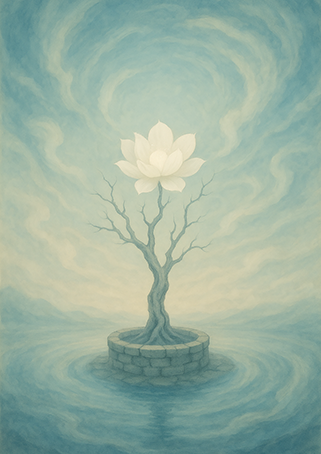Xieyi・The Rootless Tree:100 Verses-Verse 52#292

The poems of “The Rootless Tree” express a fundamental force rooted in harmony with heaven and earth, the cyclical flow of yin and yang, and the infinite potential of existence。
This painting is an expressive “Xieyi” in the tradition of “futu” (spiritual diagrams), passed down for generations in Wudang Mountain, China. It is drawn through a technique where energy flow (xingqi) channels the internal intention into visual form。 In the Taoist world, there exist spiritual and symbolic images called “futu”。
In the Taoist world, there exist spiritual and symbolic images called “futu”。
These are a type of talisman—not merely religious items, but expressive spiritual paintings that act directly on the mind of the viewer。
Since ancient times, many people have placed these Taoist-style “Xieyi” and futu in their homes, studies, or bedrooms, wishing for longevity, health, auspiciousness, and family harmony. Viewing such paintings was not just aesthetic appreciation, but an act of inviting the presence of the Dao into one’s life and tuning the body and mind。
Thus, “Xieyi” is more than artistic expression—it is a medium that bridges the spirit, life, and harmony with the universe。
This kind of artwork is not meant to be seen only with the eyes, but felt with the heart。
It communicates with the Dao, resonates with the qi of nature, and quietly stirs the viewer’s inner self。
Futu and “Xieyi” continue to live on from ancient times to this day as “sacred images that speak to the soul.”
Below, we present the original text of the philosophical poem “The Rootless Tree,” along with a modern Japanese translation and interpretation。
※ The author of “The Rootless Tree,” Zhang Sanfeng (1247–?), is also renowned as the founder of Tai Chi, and it is said that he applied the essence of this work to Tai Chi. As an additional note, we include an interpretation connecting this to the Tai Chi tradition of Wudang Mountain.
The Rootless Tree・Verse 52

▶Original Text
無根樹,花正靜,心如古井,氣潤無聲。無思無慮,形隨意動,萬境皆空,道自分明。
▶Modern Translation
A flower blooms in perfect stillness on the rootless tree.
Heart rests like an ancient well, qi nourishes without a sound.
Thoughts fade, the body moves with intention alone;
All phenomena are void—Dao becomes self-evident.
▶Interpretation
[無根樹,花正靜] A flower blooming in stillness—inner richness without noise.[心如古井,氣潤無聲] Mind as an ancient well; qi nourishes quietly and deeply.
[無思無慮,形隨意動] No thoughts, no worries; the body moves by intent.
[萬境皆空,道自分明] All is void—through emptiness, the Dao reveals itself.
▶Interpretation related to Tai Chi
Practice stillness to cultivate internal abundance.
Quiet, deep qi flow mirrors inner calm.
Let body follow intention—free from mental distraction.
Seeing beyond form leads naturally to Dao.
Copyright © MASAKI WAKABAYASHI. All rights reserved.




